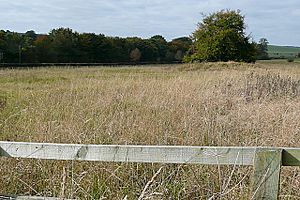Seven Barrows facts for kids
| Site of Special Scientific Interest | |
 |
|
| Area of Search | Berkshire |
|---|---|
| Interest | Biological |
| Area | 4.0 hectares (9.9 acres) |
| Notification | 1987 |
| Location map | Magic Map |
Seven Barrows is a special place in Berkshire, near Lambourn. It covers about 4 hectares (that's like 10 football fields!). This area is protected because it's super important for both its amazing nature and its ancient history.
It's known as a Site of Special Scientific Interest (SSSI) because of its unique plants and animals. It's also a Scheduled Monument, which means it's an important historical site protected by law. The Berkshire, Buckinghamshire and Oxfordshire Wildlife Trust helps look after this cool spot.
Discovering Seven Barrows
Seven Barrows is a fascinating place where nature and history meet. It's protected to make sure its special features last for a long time.
A Peek into the Past: Bronze Age Burials
Long, long ago, during the Bronze Age (which was thousands of years ago!), this area was used as a cemetery. You can still see scattered bowl barrows here. A bowl barrow is like a big, round mound of earth that people built to bury important people. It's a bit like an ancient tomb! These barrows tell us a lot about how people lived and honored their dead in the past.
A Home for Wildlife: Plants and Butterflies
Seven Barrows is also a fantastic place for nature lovers. The land here is a special kind of chalk grassland. This means the soil is chalky, and it hasn't been changed much by farming. Because of this, many different kinds of plants can grow here. More than 100 different types of herbs have been found!
This rich plant life makes Seven Barrows a perfect home for lots of insects, especially butterflies. You might spot many beautiful butterflies flying around, such as:
- The small blue
- The brown argus
- The chalkhill blue
- The dark green fritillary
- The rare marsh fritillary
It's a busy place with buzzing insects and colorful wings, showing how important it is to protect these natural habitats.

